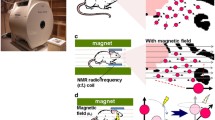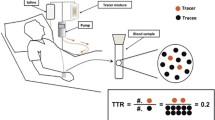Abstract
As a noninvasive method,in vivo 13C nuclear magnetic resonance has potentially important applications in understanding the metabolism of long chain fatty acids in organs of living humans. At present, this methodology is most advanced for research on glucose utilization. However, the main13C signals visiblein vivo are from fatty acids in adipose tissue and the olefinic signals can be used to noninvasively estimate adipose tissue content and relative dietary intake of polyunsaturates and monounsaturates. The low natural abundance of13C improves the utility of this isotope for fatty acid tracer studies. Due to excessive signal broadening, uniform13C-labelling seems to have limited application inin vivo fatty acid studies. Tracer fatty acids with13C enrichment at a specific carbon position, i.e., [3-13C]γ-linolenate, appear to be the most useful forin vivo tracer studies. Development of methods permitting resolution of13C enrichment in structural lipids of lean tissues will be an important breakthrough which may make human tracer studies feasible and worthwhile.
Similar content being viewed by others
Abbreviations
- NMR:
-
nuclear magnetic resonance
- PUFA:
-
polyunsaturated fatty acid
References
Cunnane, S.C., Vogt, J., Likhodii, S.S., Moine, G., Muggli, R., Tovar, K-H., Kohn, G., and Sawatzki, G. (1995) Metabolism of [3-13C]γ-Linolenate in the Suckling Piglet and Rat inBiochemistry of GLA and its Role in Nutrition and Medicine, Eds. Huang, Y-S., and Mills, D.E., AOCS Press, Champaign, IL, in press.
Cunnane, S.C., Williams, S.C.R., Bell, J.D., Brookes, S., Craig, K., Iles, R.A., and Crawford, M.A. (1994) Utilization of [U-13C]-Labelled Polyunsaturates in the Synthesis of Long Chain Fatty Acids and Cholesterol Accumulating in the Neonatal Rat Brain,J. Neurochem. 62, 2429–2436.
Canioni, P., Alger, J.R., and Shulman, R.G. (1983) Natural Abundance13C NMR of Liver and Adipose Tissue of the Living Rat,Biochemistry 22, 4974–4980.
Bottomley, P.A., Hardy, C.J., Roemer, P.R., and Mueller, O.M. (1989) Proton-Decoupled, Overhauser-Enhansed, Spatially-Localized13C NMR in Humans,Magn. Res. Med. 12, 348–363.
Beckmann, N., Turkalj, I., Seelig, J., and Keller, U. (1991)13C NMR for the Assessment of Human Brain Glucose Metabolismin Vivo, Biochemistry 30, 6362–6366.
Shulman, G.I., Rothman, D.L., Jue, T., Stein, P., DeFronzo, R.A., and Shulman, R.G. (1990) Quantitation of Muscle Glycogen Synthesis in Normal Subjects and Subjects with Non-Insulin Dependent Diabetes by13C NMR,New Engl. J. Med. 322, 223–228.
Beckmann, N. (1995)13 C NMR Spectroscopy of Biological Systems, pp. 7–64, Academic Press, New York.
Dimand, R.J., Moonen, C.T.W., Chu, S.C., Bradbury, E.M., Kurland, G., and Cox, K.L. (1988) Adipose Tissue Abnormalities in Cystic Fibrosis: Noninvasive Determination of Mono-and Polyunsaturated Fatty Acids by13C Topical NMR,Pediatr. Res. 24, 243–246.
Cunnane, S.C., Allman, T., Bell, B., M.J., Coutts, G., Williams, S.C.R., and Iles, R.A. (1993)In Vivo Fatty Acid Analysis in Humans and Animals Using13C NMR inHuman Body Composition, Ellis, K.J., and Eastman, J.D., pp. 355–358, Plenum Press, New York.
Fan, T.W.M., Clifford, A.J., and Higashi, R.M. (1994)In Vivo 13C NMR Analysis of Acyl Chain Composition and Organisation of Perirenal Triacylglycerides in Rats Fed Vegetable and Fish Oils,J. Lipid Res. 35, 678–689.
Chen, Z.-Y., Ratnayake, W.M.N., Fortier, L., Ross, R., and Cunnane, S.C. (1995) Trans Fatty Acids in the Adipose Tissue of Canadians,Can. J. Physiol. Pharmacol. 73, 718–728.
Field, C.J., Angel, A., and Clandinin, M.T. (1985) Relationship of Diet to the Fatty Acid Composition of Human Adipose Tissue Structural and Stored Lipids.Am. J. Clin. Nutr. 42, 1206–1211.
Hellerstein, M.K., Christiansen, M., Kaempfer, S., Kletke, C., Wu, K., Reid, J.S., Mulligan, K., Hellerstein, N.S., and Schackleton, C.H.L. (1991) Measurement ofde novo Lipogenesis in Humans Using Stable Isotopes,J. Clin. Invest. 87, 1841–1852.
Beckmann, N., Brocard, J.-J., Keller, U., and Seelig, J. (1992) Relationship Between the Degree of Unsaturation of Dietary Fatty Acids and Adipose Tissue Faty Acids Assessed by Natural Abundance13C Magnetic Resonance Spectroscopy in Man,Magn. Reson. Med. 27, 97–105.
Likhodii, S.S., and Cunnane, S.C. (1996) Utilization of Carbon from Polyunsaturates for Synthesis of Brain Cholesterol in the Developing Rat: A13C NMR Study,Magn. Res. Med., in press.
Author information
Authors and Affiliations
About this article
Cite this article
Cunnane, S.C., Likhodii, S.S. & Moine, G. In vivo13C nuclear magnetic resonance: Applications and current limitations for noninvasive assessment of fatty acid status. Lipids 31, S127–S130 (1996). https://doi.org/10.1007/BF02637063
Issue Date:
DOI: https://doi.org/10.1007/BF02637063




